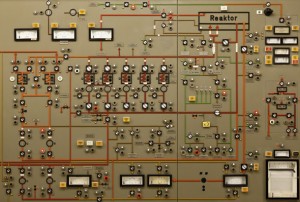Volker Sattel’s Film Brings Nuclear Power Under Control at the Hirshhorn
Volker Sattel’s haunting film “Under Control” takes the viewer behind the scenes for a stylized look at day-to-day operations at nuclear power plants
/https://tf-cmsv2-smithsonianmag-media.s3.amazonaws.com/filer/20111115111004UnderControlCrop.jpg)
Brush up on your German, zip up your lead-lined pants and bring your NukAlert badge when you go check out the film Under Control tonight, Tuesday, November 15, at 7:00 at the Hirshhorn Museum. This timely work explores both the design aesthetics and the behind-the-scenes of what really happens behind the scenes at nuclear reactors.
Filmed in the wide-screen Cinemascope, the camera moves deliberately over several locations, running the gamut from active nuclear plants, decommissioned reactors, training classes and radioactive waste storage facilities—even shooting over an open research reactor while the fuel rods were being changed. Kind of gives you a warm, glowing feeling, doesn’t it?
Hollow, echoing sounds reflect the underlying menace that’s present. Yet there’s an appeal to the clean lines of the sterile, industrial design and a retro Eastern European feel to the furniture and instrument panels that ironically control some of the most powerful forces on the planet.
Hirshhorn associate curator Kelly Gordon first saw the piece at the Berlin Film Festival this past February and came away impressed. “It is a mind-blowing study of the haunting elegance of the hardware of the industry,” she says. “The film meditates on the poetry of technology but also the echo of mass destruction.”
Director Volker Sattel, who will be on hand for tonight’s screening, came up with the idea for the piece in 2007 while in Vienna. He was visually inspired by the concentric construction of UNO-City, the 1970s-style high-rise headquarters of the International Atomic Energy Agency (IAEA). Additionally, the men in dark suits and stylishly-dressed women there reminded him of the men-in-black portrayal of the secret service in American cinema.
Sattel actually grew up where nuclear reactor towers loomed on the horizon, in the German town of Speyer. He brings an objective and stylized eye to the German nuclear discussion.
“We encountered an industrial-scale technology that was both fascinating and creepy at the same time,” Volker told Berlin Art Link in April of 2011. “Looking at the long term, you can sense the enormous challenges and ludicrous efforts that this form of energy generation demands of human beings.”
/https://tf-cmsv2-smithsonianmag-media.s3.amazonaws.com/accounts/headshot/Jeff-Campagna-240.jpg)

/https://tf-cmsv2-smithsonianmag-media.s3.amazonaws.com/accounts/headshot/Jeff-Campagna-240.jpg)